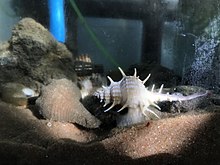Neogastropoda
| Neogastropoda Temporal range: Early Cretaceous-Recent
| |
|---|---|

| |
| The shell of a neogastropod, the muricid species Chicoreus palmarosae | |
| Scientific classification | |
| Domain: | Eukaryota |
| Kingdom: | Animalia |
| Phylum: | Mollusca |
| Class: | Gastropoda |
| Subclass: | Caenogastropoda |
| Order: | Neogastropoda Wenz, 1938 |
| Superfamilies | |
|
See text | |
Neogastropoda is an
Description

The available
These sea snails have only one auricle, one kidney and one monopectinate gill, i.e. the gill filaments develop on only one side of the central axis.[4]
The
The nervous system is very concentrated. Many species have the ganglia in a compact space.
The rachiglossate (rasp-like) radula, a layer of serially arranged teeth within the mouth, has only three denticles (small teeth) in each transverse row.[4]
The Neogastropoda have
There are about 16,000 species. Neogastropoda includes many well-known gastropods including the
Taxonomy
According to the taxonomy of the Gastropoda by Bouchet & Rocroi (2005) the clade Neogastropoda consists of these superfamilies:
- Rafinesque, 1815
- Conoidea Fleming, 1822
- Cancellarioidea Forbes & Hanley, 1851: since 2017 treated as the superfamily VolutoideaRafinesque, 1815
- Mitroidea Swainson, 1831 : added in 2017 [5]
- Rafinesque, 1815
- Latreille, 1825
- † Pholidotomoidea Cossmann, 1896
- Pseudolivoidea (de Gregorio, 1880): since 2017 treated as a synonym of the superfamily OlivoideaLatreille, 1825
- Turbinelloidea Rafinesque, 1815
- Volutoidea Rafinesque, 1815
When Neogastropoda was an order, it was placed within the prosobranch
Ever since Thiele (1929),
Families
According to the taxonomy of the Gastropoda by Bouchet & Rocroi (2005) the taxonomy of clade Neogastropoda is as follows:
- Unassigned to a superfamily
- † Family Johnwyattiidae
- † Family Perissityidae
- † Family Sarganidae
- † Family Speightiidae
- † Family Taiomidae
- † Family Weeksiidae
- Superfamily Buccinoidea
- Family Belomitridae Kantor, Puillandre, Rivasseau & Bouchet, 2012
- Family Buccinidae
- Family Busyconidae Wade, 1917 (1867)
- Family Colubrariidae
- Family Columbellidae
- † Family Echinofulguridae Petuch, 1994
- Family Fasciolariidae
- Family Melongenidae
- Family Nassariidae
- Superfamily Mitroidea Swainson, 1831
- Family Charitodoronidae Fedosov, Herrmann, Kantor & Bouchet, 2018
- Family Mitridae
- Family Pyramimitridae Cossmann, 1901
- Superfamily Muricoidea
- Family Muricidae
- Family Babyloniidae
- Family Costellariidae
- Family Cystiscidae
- Family Harpidae
- Family Marginellidae
- † Family Pholidotomidae
- Family Pleioptygmatidae
- Family Strepsiduridae
- Family Turbinellidae
- Family Volutidae
- Family Volutomitridae
- Superfamily Olivoidea
- Family Olividae
- Family Olivellidae
- Family
- Superfamily Pseudolivoidea: since 2017 treated as a synonym of the superfamily OlivoideaLatreille, 1825
- Family Pseudolividae
- Family Ptychatractidae
- Superfamily Conoidea
- Family Conidae
- Family Clavatulidae
- Family Drilliidae
- Family Pseudomelatomidae
- Family Strictispiridae
- Family Terebridae
- Family Turridae
- Superfamily Cancellarioidea: since 2017 treated as the superfamily VolutoideaRafinesque, 1815
- Family Cancellariidae
References
This article incorporates CC BY 2.0 text from the reference.[3]
- ^ "WoRMS - World Register of Marine Species - Neogastropoda". www.marinespecies.org. Retrieved 27 September 2018.
- ^ "Neogastropoda". Integrated Taxonomic Information System. Retrieved 27 September 2018.
- ^ BMC Evolutionary Biology2009, 9: 210. 10.1186/1471-2148-9-210
- ^ ISBN 978-0-03-056747-6.
- ^ Bouchet P., Rocroi J.P., Hausdorf B., Kaim A., Kano Y., Nützel A., Parkhaev P., Schrödl M. & Strong E.E. (2017). Revised classification, nomenclator and typification of gastropod and monoplacophoran families. Malacologia. 61(1-2): 1-526
- ^ Thiele J. (1929). Handbuch der Systematischen Weichtierkunde Volume 1 (1) (Loricata; Gastropoda: Prosobranchia). Jena, 376 pp. In: (23 October 1929). Reprint, Asher & Co., Amsterdam, 1963; translation by J.S. Bhatti Edited by: R. Bieler & P. Mikkelsen, Smithsonian Libraries, 1993.
- ^ Kantor YI. (1996). Phylogeny and Relationships of Neogastropoda. In: Taylor J. D. (ed.) Origin and Evolutionary Radiation of the Mollusca. Oxford, Oxford University Press, 221-230.
- ^ Ponder W. F., Colgan D. J., Healy J. M., Nützel A., Simone L. R. L. & Strong E. (2008). Caenogastropoda. In: Ponder W. F., Lindberg D. R. Phylogeny and evolution of the Mollusca. Berkeley, University of California Press, 331-383.
- Bandel, K. & Dockery, D.T. III (2012): Protoconch characters of Late Cretaceous Latrogastropoda (Neogastropoda and Neomesogastropoda) as an aid in the reconstruction of the phylogeny of the Neogastropoda. – Freiberger Forschungshefte, C 542 psf (20): 93-128, pls. 1-5.
External links
- Neogastropod Tree of Life
- Crame J. A. (2013). "Early Cenozoic Differentiation of Polar Marine Faunas".
